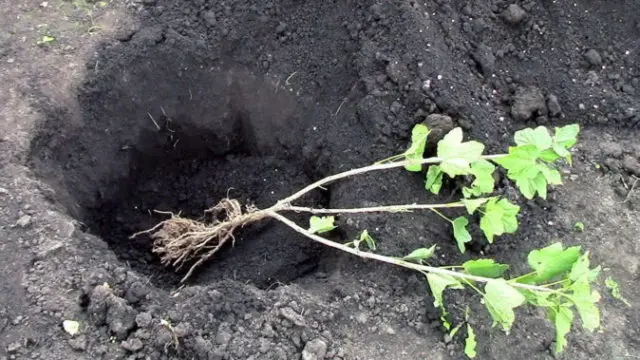Contents
- Features of growing and fruiting gooseberries
- When is the best time to plant gooseberries: spring or summer
- How to plant gooseberries in spring
- How to grow gooseberries in the country or in the backyard
- How to grow gooseberries on a trellis
- Pests and diseases
- Conclusion
Planting gooseberries in spring in open ground with the implementation of the rules of agricultural technology of this crop will allow you to get a plentiful and high-quality harvest of berries. The preparation of planting material, the choice of a suitable place and the observance of planting dates lay the foundation for the health of the shrub. Regular plant care and disease prevention is a guarantee of long fruiting.
Features of growing and fruiting gooseberries
Gooseberry is an unpretentious, high-yielding berry shrub that is widely used in domestic horticulture. “Northern grapes”, as this plant is also called, is winter-hardy, some of its varieties can bloom even with slight frosts. Hybrids resistant to pests, powdery mildew, sferoteka, black spot have been selected.
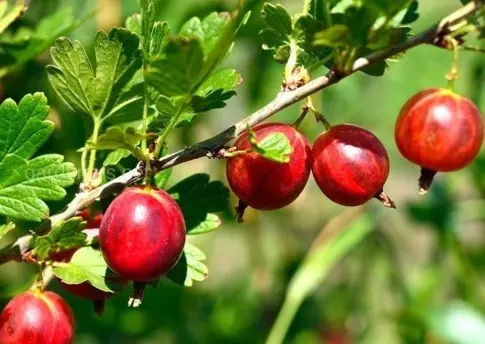
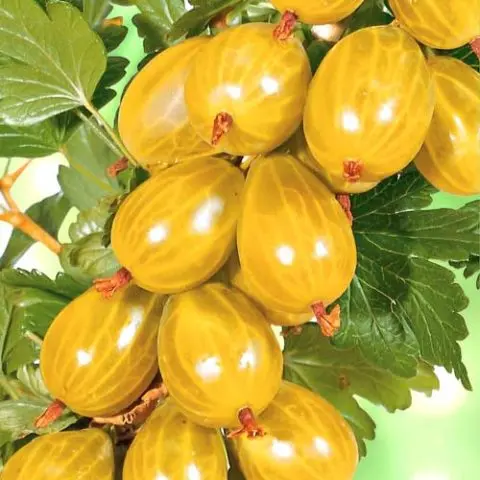
Gooseberries are a drought tolerant crop. A dry regime is more preferable than heavy rains, close occurrence of groundwater and spring floods. To get high yields, the plant needs to provide enough light. In a shaded place, the shrub is overgrown with long branches, on the tops of which berries are formed. Shoots located in the shade are poorly leafy, prone to freezing and disease. For active growth and development, loose and nutritious soil, without weeds, is needed, which begins to be prepared a year before planting in the spring. There are no special requirements for its composition. It can be clay, sandy or peaty.
What year after planting does the gooseberry bear fruit?
Gooseberries begin to bear fruit in the third year after planting. The first harvests are not plentiful. With the age of the culture, the quality of the berries improves, the yield increases.
When the gooseberry ripens
The fruiting time of the gooseberry depends on the region of its growth:
- in the south, the fruits are ripe by the beginning of July;
- in the Middle Strip and the Moscow region, berries ripen in the middle of summer;
- in Siberia and the Urals, the culture begins to bear fruit by the end of July – the beginning of August.
Ripening time depends on the variety. Early, middle, late varieties of gooseberries have been bred. Fruit ripening on a bush can be simultaneous or extended.
How many fruits gooseberries
Gooseberries begin to ripen 2-2,5 months after flowering. For a long time, about three weeks, they can stay on the bush and not crumble even after overripe.
For about 30 years and even more, with proper care, gooseberries give good yields. High fruiting persists until the age of 15 years. From one bush you can get up to 15 – 20 kg of berries per season.
When is the best time to plant gooseberries: spring or summer
Planting gooseberries in spring is more preferable than in summer. Due to the optimal air temperature and abundant soil moisture after the snow melts, the seedlings take root well, the bush is actively developing.
Why you can not plant gooseberries in the summer
In summer, it is impossible to plant gooseberries with seedlings with an open root system. Hot weather does not contribute to the rapid development of the shrub. It does not take root well and usually disappears a few months after planting.
In the summer, propagation of the culture by cuttings can be successful. The cuttings cut off from the bush are dug into fertile soil and watered abundantly. By winter, such a plant has time to take root well.
Terms of planting gooseberry seedlings in the spring
In the spring, the choice of the gooseberry planting time affects a successful result. This culture comes out of winter sleep very early. If you plant a bush with swollen buds in the ground, then it will hurt and, most likely, die. Thus, in the spring, the plant is planted, taking into account the peculiarities of the climate of the territory, choosing the time after the ground has thawed and the snow cover has melted.
When to plant gooseberries in different regions
In the spring, the timing of planting in the ground is determined by the climatic characteristics of the area:
- The regions of the Middle Strip and the Moscow region are located in a zone with a temperate continental climate. Here, the best time for planting gooseberries in the spring, in April.
- The climate of Siberia and the Urals is continental, characterized by harsh conditions. In these regions, gooseberries are planted in late April – early May.
- In the southern regions, the climate varies from subtropical to temperate continental. Spring comes early here, and you can plant a plant in open ground as early as March – early April.
The timing of planting gooseberries is determined by the possibility of acquiring a seedling and the gardener’s preferences.
How to plant gooseberries in spring
In order for the gooseberry to bear fruit abundantly, it should be planted in the spring, following the step-by-step instructions: choose the right place for placement, prepare the soil and planting material, plant the seedlings correctly.
Where is it better to plant gooseberries on the site
To place the gooseberry, preference is given to well-lit areas, avoiding the proximity of buildings and structures that can obscure the bush. Trees and shrubs growing nearby interfere with plant development by absorbing nutrients.
It is better to plant gooseberries on a flat, flat place, protected from winds, especially cold northern and western ones. Groundwater should lie no closer than 1,5 m to the ground surface. If the roots of the plant are constantly damp, they will begin to rot, which will lead to its death.
Gooseberries prefer areas with loamy, non-acidic soils with good drainage performance. Limestone solution can be used to reduce soil acidity. Sandy and marshy soils are not suitable for growing plants.
Next to what you can plant gooseberries
Gooseberries can be planted nearby:
- with other species of this plant – they self-pollinate well, are less affected by diseases and pests;
- with red currant – they bloom and bear fruit at the same time, do not have common pests, do not compete for nutrients;
- with herbs (basil, mint, lemon balm) – this smell repels insects;
- with tomatoes, which serve to protect the culture from parasites, they are often planted between rows of gooseberries.
Next to what you can not plant gooseberries
Planting gooseberries next to some crops leads to a decrease in its yield, disease, and in some cases death. This shrub cannot be planted nearby:
- with trees and bushes that create shading and compete with the plant for food;
- blackcurrant, which has common diseases and parasites with gooseberries;
- raspberries and strawberries, which attract nutrients and attract moths, weevils, aphids;
- fennel and hyssop, which release substances into the soil that adversely affect the development of garden plants.
How to prepare the soil for planting gooseberries
In the territory chosen for the placement of the gooseberry, the soil is carefully prepared in the fall. It is dug over the entire area of u18bu20bthe site, weeds are removed and its roots are selected. In spring, the soil surface is leveled with a rake, breaking up clods. When digging, XNUMX-XNUMX kg of organo-mineral compost are added to the areas allotted for shrubs.
Selection and preparation of planting material
You can plant gooseberries in the spring with seedlings. The survival and health of the plant depends on their quality. Choose a biennial planting material that must meet the following criteria:
- so that its ground part consists of 2 – 3 branches up to 40 cm long;
- rhizome – was represented by at least three lignified skeletal processes 15 cm long, with a yellowish bark and well-developed urinary components.

In addition to seedlings, cuttings are used as planting material. They are prepared in the fall, and transplanted to a permanent place in early spring, before the start of the growing season. Cuttings are carried out according to one of the schemes:
- In September, a young one-year-old twig is chosen, growing from the root. It is cleaned of leaves and cut into pieces 20 cm long. The upper cut is made over the kidney. The cuttings are immersed for 15 minutes in water at a temperature of 45 degrees to prevent damage by kidney mites. Then the cutting is planted at an angle of 450 into the ground, leaving two buds above the surface;
- Small green shoots are cut, up to 10 cm long, with a lignified heel from last year’s branch and planted according to the scheme described for the first case.
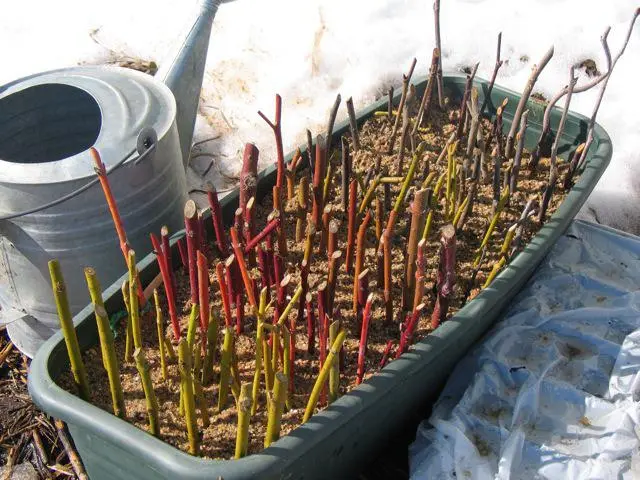
In the spring, before planting, to ensure good survival, the seedling is prepared:
- Gooseberries are examined for the presence of fungal diseases and mold.
- Remove dried or damaged parts of shoots and roots.
- Shoots are cut to 4 buds. This will allow the developing root system to provide sufficient nutrients to the ground part.
- Immerse seedlings for 3-5 minutes in a transparent pink solution of potassium permanganate (potassium permanganate) for disinfection.
- The roots of the seedling to stimulate root formation are lowered for 2-3 minutes into a stimulator or rooter. For this purpose, you can use a clay mash, which resembles thick sour cream in consistency.

How to save gooseberry seedlings before planting
In the spring, gooseberry seedlings with open (OKS) and closed (ZKS) root systems go on sale. The general rules for their storage are that planting material should not be brought into a warm room, because this can stimulate plant growth. But there are differences:
- Seedlings with ZKS, that is, grown in a container, should be well watered and stored in a cool room or outdoors, in a shady place;

- If the root system of the seedling is open, then it is wrapped in cloth or paper, moistened and kept in the shade. In the spring, before planting, you can dig seedlings, sprinkling the roots with earth and watering well.

Advice! In the spring, in order to protect seedlings from late frosts when stored outdoors, they are wrapped with non-woven covering material.
The advantage of container-grown specimens is that they can be planted throughout the growing season (spring and summer) and have an almost 100% survival rate. If a plant is purchased with ACS, then it is better to plant it in the ground as soon as possible. The advantage of such planting material is that it is possible to fully examine the plant and assess its condition.
At what distance to plant gooseberries
Important in order to plant gooseberries correctly in the spring is the distance at which the plants are placed from each other. This is a light-loving spreading shrub, and its yield depends on the illumination.
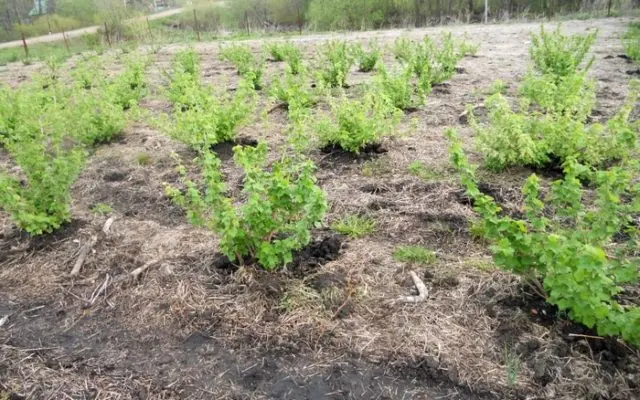
The density of gooseberry placement is determined by the variety, soil fertility, illumination, the method of shrub formation, and the expected service life. Of paramount importance for a proper landing in the spring is the layout:
- With the usual sparse placement scheme, plants are planted in rows with an interval of 1,4 – 1,5 m. The row spacing should be 2 – 2,5 m. Shrubs in a row for the 5th – 6th year begin to close and form a continuous strip.
- The combined method consists in the fact that the bushes are first planted tightly (the distance in the row is 0,75 m, and between them is 1 m), and then the rows are gradually thinned out. In the spring of the 3rd – 4th year, the bushes are removed from them after one and transplanted to a new place. Then the distance between the gooseberries in the row will remain 1,5 m. Then again, after 1 – 2 years, the density of the plantation is reduced by removing the shrubs growing through the row. By the 7th year, they gradually move to the usual landing pattern.Comment! If a shrub is planted according to a combined scheme, then high yields are harvested from a young berry plant located in a small area.
- When planting two copies to increase productivity, they are placed in one large hole at a distance of 0,2 m from each other. But this method is not justified. In the first years, the yield of bushes is high, then they thicken, their roots intertwine, and they quickly age. It is difficult to plant them without damage.
- When placed between rows in a young garden, gooseberries are planted, stepping back from the trees at least 1,5 – 2 m. If their crowns begin to close, in the spring the plant is transplanted or removed.
If a decision is made to grow gooseberries on a trellis, they are planted according to a compacted scheme: the interval between shrubs in a row will be 0,5 – 0,7 m, and between rows – 3 m.

When placing a berry plant, the minimum allowable distance to landscape design objects and communications is taken into account:
- to the fence – 1 m;
- to garden paths – 0,5 m;
- to the walls of buildings – 1,5 m;
- to underground cables – 0,7 m.
How to plant gooseberries in spring
Proper planting of gooseberries in the spring consists of the following mandatory steps.
Feed preparation.
For each planting pit, a mixture of fertilizers is preliminarily prepared:
- humus – 1,5 – 2 buckets;
- peat – 2 buckets;
- superphosphate – 300 g;
- potassium salt – 30 – 40 g;
- wood ash – 300 g;
- ground limestone -150 g.
Well preparation
Holes or trenches are prepared at least 2 weeks before planting gooseberries: in order for the soil to naturally subside. They dig holes with a size of 0,5×0,5×0,5 m. In this case, you can focus on the spade bayonet: depth – 1,5 bayonets, diameter – 2 bayonets.
With the earth removed from the holes, proceed as follows:
- the upper fertile soil is mixed with pre-prepared top dressing and laid on the bottom of the pit in the form of a slide;
- the soil of the lower layer of the hole is distributed between the rows, and instead, the top layer of earth, previously removed from the surface between the rows, is used to backfill the pit.
Gooseberries are planted in prepared holes.
Planting of seedlings
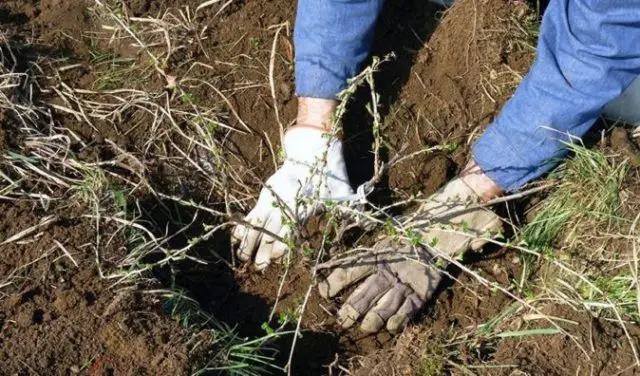
In the spring, after advance preparation and inspection, you can plant gooseberries, according to this step-by-step guide:
- Step 1. Place the seedling on top of the hill at the bottom of the planting nest so that the root collar is 5-7 cm below ground level. Spread down the roots;
- Step 2. Pour prepared soil into the planting nest, removed from the top layer of the hole and mixed with top dressing. The gooseberry seedling must be shaken periodically for uniform and dense laying of the soil;
- Step 3. To remove the remaining air and compact the soil, after filling the hole, not reaching 10 – 12 cm to the edge, pour plenty of gooseberries from a watering can with water in the amount of 2/3 of a bucket. Top up all the soil and spill the remaining water (1/3 bucket);
- Step 4. Mulch the trunk circle. You can use peat or compost as mulch, laying it in a layer of 3 – 4 cm;
- Step 5. During spring planting, the branches of the seedling should be shortened, leaving 3-4 buds each. This balances the volume of the crown and root system, facilitating the nutrition of a young plant.
The described scheme for planting gooseberries is shown in the figure.
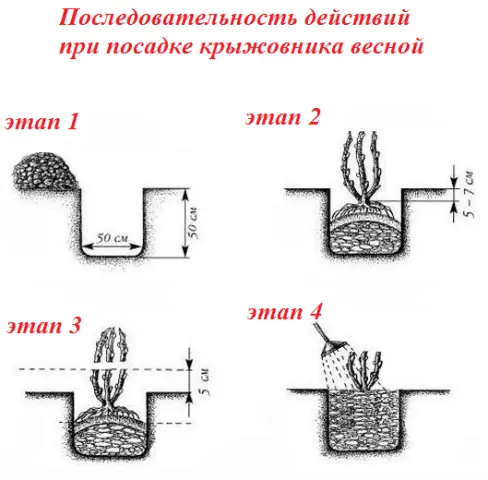
You can achieve good survival by planting gooseberries according to the simplified method presented in the video:
Planting gooseberries in the spring when grown on a trellis is slightly different from the traditional scheme. A trellis with a height of at least 2 m is preliminarily installed. Wooden or metal beams are used for supports, between which a wire is pulled in parallel in three tiers. Then, next to the trellis, with an interval of 0,5 m, gooseberry bushes are planted in holes or trenches. The dimensions of the landing nests are the same as in the traditional landing. After that, they proceed to the formation of shrubs.
How to grow gooseberries in the country or in the backyard
Growing gooseberries in a personal plot is accompanied by mandatory care procedures. To obtain a high-quality crop, you should follow the irrigation and fertilization schedule, loosen and mulch the soil, and properly cut the bush in spring and autumn.
What to do if frosts begin after planting gooseberries
Gooseberries, especially young and immature ones, are sensitive to return frosts. To protect plants planted in spring, they are wrapped with burlap, paper or film. It is optimal to use non-woven covering material for protection.
Smoke is a long-known, but difficult way to protect against late frosts. Smoke is difficult to keep in the area. This procedure is accompanied by a constant unpleasant smell of a fire.
Watering and fertilizing schedule
The first watering of gooseberries is carried out on the 3rd – 4th day after planting in the spring. Then the seedling is watered once a week until rooting. Next, regular soil moisture is required at a set time:
- в maе – with the growth of new branches;
- in July – when berries ripen;
- in October – to provide moisture for the winter.
Fertilizers are applied for the first time in the spring, during planting. Then, starting from the age of three, gooseberries are fed 4 times a year: before bud break, before flowering, before fruit formation, after they are harvested. The basis of top dressing is rotted manure (1:10) or bird droppings (1:20). In spring and autumn, a complex fertilizer is used, which includes superphosphate, saltpeter, potassium chloride.
Loosening and mulching the soil
Around the young plant, the soil is regularly loosened to saturate it with air, and weeds are removed. Trunk circles are mulched using compost or peat after each watering and heavy rainfall.
Trimming and installation of supports
For the correct formation of the gooseberry crown and the prevention of diseases, they regularly, in autumn and spring, carry out a shaping, sanitary and rejuvenating haircut. Remove diseased and unproductive branches. For the first time, the bush is immediately cut off the planting field, leaving no more than 4-6 buds on the shoots. The root system of the seedling will not be able to ensure the vital activity of a larger volume of the ground part.
Around the gooseberry bushes of tall varieties in the spring for the 2nd – 3rd year, supports are installed, to which, as necessary, branches are tied. Supports can be stake, trellis or frame.
How to grow gooseberries on a trellis
Gooseberries can be planted in the spring to grow on a trellis. This is a rational way to ensure early and uniform formation of berries and the convenience of harvesting.
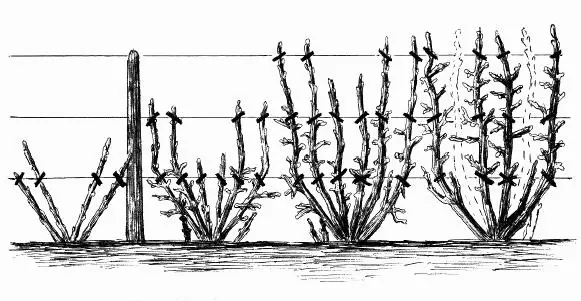
The trellis is installed from north to south for good illumination of shrubs. The wire on it is pulled in three tiers (50; 80; 100 cm above the ground). Gooseberries with this method of cultivation are formed as follows:
- On the bushes, of all the shoots that have grown in the first year, 3-4 of the most developed ones are retained. In the spring they are fixed on the first tier, with an interval of 20 – 30 cm.
- In the second year, the left shoots, without shortening, are tied to the wire of the second tier. The central branches are removed.
- In the third year, two basal branches are additionally left on the gooseberry to rejuvenate the bush. And the side shoots are tied to the third tier.
- In autumn or spring, on the 4th – 5th year, the old branches are cut out, two young annual shoots are left in their place. This is how the bush is rejuvenated throughout its entire life cycle.
- Shoots that grow from the root neck are constantly removed.
The thorns of the bush formed in this way do not complicate the harvest. All berries are in the same plane. They are large and mature quickly.
Pests and diseases
Pest and disease control is an indispensable component of competent gooseberry care. This culture is susceptible to viral and fungal diseases, it is affected by insects. Therefore, young and adult shrubs need preventive treatment with solutions:
- baking soda;
- carbofos;
- iron sulfate.
Conclusion
Planting gooseberries in spring in open ground and timely implementation of crop care procedures give results in the form of a harvest of large berries with high taste characteristics. It is planted taking into account varietal characteristics and the chosen layout. Growing and planting shrubs on a trellis has its differences.











